Mehul Reuben DasFeb 21, 2023 10:54:17 IST
Pros
– Sheer Performance
– Pricing compared to competitors
– Larger Cache and Core Count
– Solid multicore and single-core performance
– Hybrid Architecture
– Compatible with previous Chipsets
– Performance almost at par with the i9 at just a fraction of the cost
Cons
– Power consumption
– Needs a proper cooling solution to extract all the performance.
– Possibly the last generation of CPUs using the LGA 1700 Socket
Price: Rs 44,500
Rating: 4.5/5
Intel 13th Gen i7 13700K Review: Overview
Intel’s i7 lineup of CPUs has been the best for high-end desktops, dedicated to gaming, for years now. Yes, there’s the i9 lineup of Intel CPUs, but unless you’re a serious content creator who’ll actually use all the cores at their highest speeds, the i9 would be like taking a fighter jet to a gunfight. Yes, you can do that, but that’s one overachieving response if there ever was one.
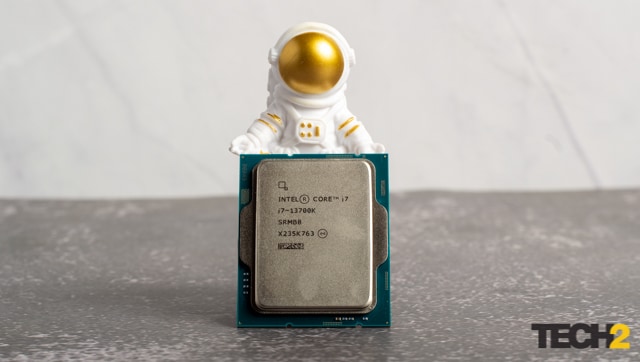
The lower-tiered i5 13600K is a solid mid-tier performer and has been crucial in establishing Intel’s position as the go-to CPU for mid-tier gaming. The i7-13700K takes all that performance, turns the dial up to 11 and just goes for it.
For a few years now, Intel has had to play catch up with AMD’s Ryzen series and the performance they offered across different price points. With the 13th Gen Intel processors, especially the i5 13600K and the i7 13700K, finally, team red has a competitor that gives a proper and hard fight.
What sets the latest generation of Intel’s CPUs is their hybrid architecture. Intel started their current hybrid architecture with the Alder lake lineup. With Raptor lake, Intel has fine-tuned and turned the dial all the way to 11.
Although the 13th Gen CPUs are still based on the same Intel 7 process as the 12th Gen, and it has the same hybrid design of performance cores (P-cores) and efficiency cores (E-cores), the Core i7 13700K has the same number of cores as the Intel Core i9 12900K from the previous generation. All in all the i7 13700K CPUs have twice as many E-cores as the previous generation. Basically, you get 8 Performance cores and 8 Efficiency and 24 threads.
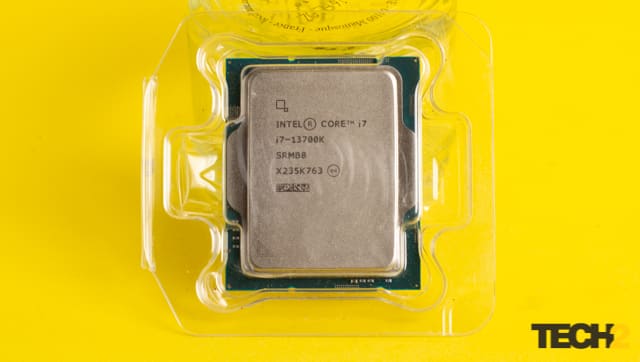
It genuinely is a better version of the i9 12900K but for a lot less money. Because hyper-threading is enabled on the core i7 13700k, the P-Cores have a thread count of 16. The E-Cores do not support multithreading. This basically increases the thread count on this SKU to 24 compared to the core i7 12700k’s thread count of 20.
The end result is that you get a fantastic CPU that punches above its weight class, and performs like a beast.
Intel 13th Gen i7 13700K Review: Specifications
Intel’s 13the Gen CPUs, including the Intel i5 13600K Intel and the i7 13700K is based on the Raptor lake architecture, which is a generational improvement over the Alder lake architecture. Like the previous generation of Intel CPUs, the i7 13700K uses the Intel 1700 socket and is made using the Intel 7 manufacturing process. The 13th Gen CPUs are expected to be the last CPUs built on Intel 7 before the move to Intel 4, and the last to support the Intel 1700 socket.
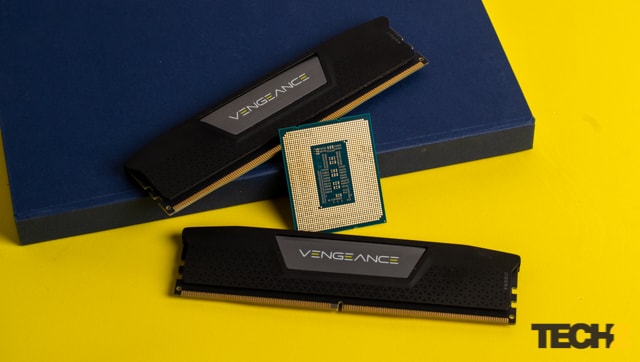
The i7 13700K comes with a total of 16 cores, which consists of 8 P-cores and 8 E-cores, and has a total of 24 threads. The P-Cores have a base clock of 3.40GHz, whereas E-Cores have a base clock of 2.50GHz. Overall, the maximum turbo frequency is 5.4GHz. This is a single thread frequency from the Turbo Boost Max Technology 3, and it is dependent on the temperature and power conditions, as well as the load type.
The P-Cores’ maximum turbo frequency is 5.3GHz. The E-Cores’ maximum turbo frequency is 4.2GHz. As for power consumption, the CPU’s power draw is 125W at base frequencies and 253W at maximum turbo frequency.
Multi-threaded performance gets another boost thanks to Intel’s hyperthreading technology on the higher-boosting P-cores.
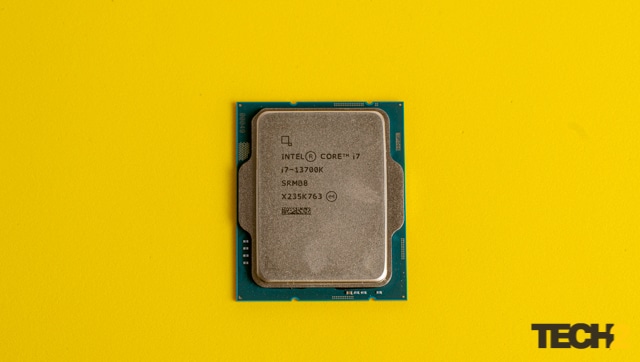
All of this makes the entire 13th Gen lineup of CPUs the first consumer-grade desktop CPUs to breach the 5GHz barrier. This also makes the 13th Generation of CPUs the fastest in the world, out of the box.
The entire L2 cache size is 24MB, while the L3 cache size is 30MB. In comparison, the Intel i7 12700K had an L2 Cachce of 14MB and and L3 cache of 25MB, whereas the Intel i9 12900K had an L2 Cache of 12MB and an L3 cache of 30MB. The increase in Caches across the board is significant.
Intel has also raised the L2 cache for each p-core from 1.25MB to 2MB and doubled the amount of L2 cache for each cluster of e-cores to 4MB in the 13700K. Intel also increased the L3 cache by 5MB.
As for the onboard graphics, the Core i7 13700K comes with UDH 770 GPU and has a base clock of 300MHz with a boost clock of 1.6GHz. It comprises 32 processing units. The maximum resolution supported by HDMI is 4096X2160 at 60Hz. On Display Port, the output resolution is 7680×4320 at 60Hz. The CPU also supports Intel Quick Sync Video and Clear Video HD technology, with a maximum display support of 4.
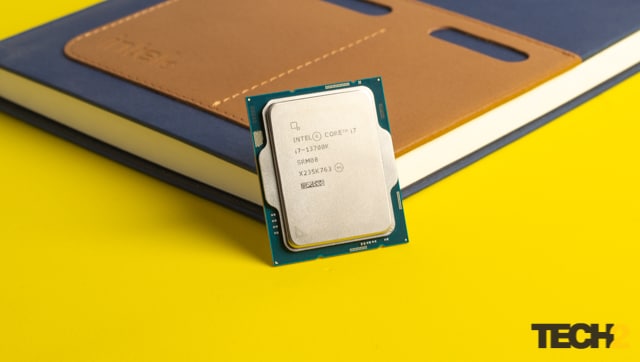
The Core i7 13700K supports both DDR4 and DDR5 RAM, just like the Core i5 13600K, and the previous-gen Alder lake CPUs. However, with the Raptor lake CPU, users get a faster DDR5 memory controller that supports DDR5 up to 5600MHz. You also get support for up to 128GB RAM in set in dual-channel configuration, along with ECC memory support.
The CPU has eight DMI lanes based on DMI 4.0. As for PCIe lanes, they are compatible with both, PCIe Gen 4.0 and 5.0 and are a total of 20, with 16 for the GPU and 4 for any compatible NVMe SSD. The SKU is compatible with PCIe Gen 4.0 and 5.0.
Intel 13th Gen i7 13700K Review: Compatibility
Although Intel’s 13th Gen CPUs come with the new Z790 chipset, they are also backwards compatible with the Z690 as well as the H670 and B660 chipsets, all of which have the LGA 1700 socket. Just ensure that your motherboards have had their BIOS and firmware updated for the 13th Gen CPUs, and you’ll be good to go.
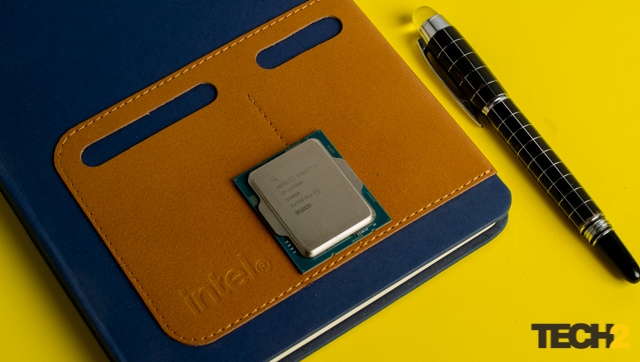
The Z690 and H670 motherboards do let you use DDR5 memory, but with varying limitations on XMP profiles, so you might want to look into that. The Z790 motherboards, though slightly expensive, are well worth the money spent for they have some new features that the Z690 and similar boards don’t. For example, a Z790 board from a reputable partner manufacturer will have PCIe 5.0 support, as well as a bunch of other creature comforts, which, in the long run, will prove beneficial.
And since this is an i7 that we are talking about, pairing it with the best available RAM would give you just that little extra boost, so again, we recommend investing in a Z790 board.
Intel 13th Gen i7 13700K Review: Our test bench
For our tests, we ran the Core i7 13700K with the Z790 motherboard. Given the power consumption of the chip, we did not want to risk leaving any performance on the table, so we went with our own MSI MAG CoreLiquid 360R V2. For RAM, we went with a pair of Vengeance 32GB kit (2x16GB) DDR5 running at 5200MHz that Corsair lent us.
For the GPU, we were using our own MSI GeForce RTX 3070 Ti Ventus 3X 8G OC, and the Corsair CX750 Watt modular PSU for power.
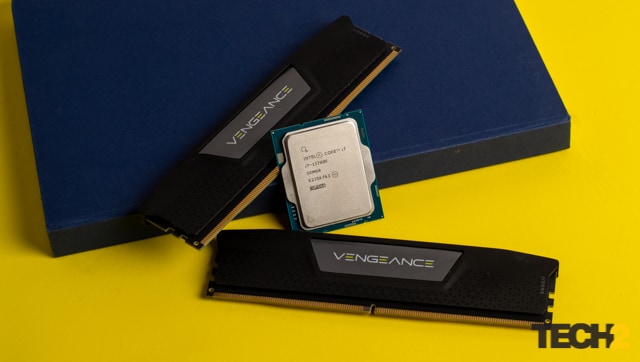
Intel 13th Gen i7 13700K Review: Performance
It should not come as a surprise that the Core i7 13700K completely annihilates the decimates the last generation Core i7 12700K across benchmarks. What is surprising though is that it performs just as well as the last generation Core i9 12900K, in a number of scenarios, with very few sacrifices in terms of power consumption and temperatures. This is in continuation of our findings when we reviewed the Core i5 13600K.
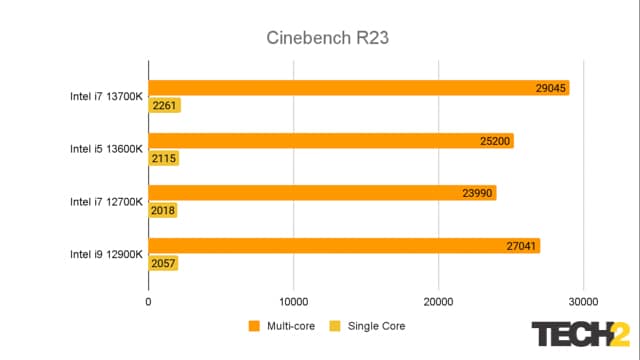
There are a number of reasons why the 13th Gen CPUs are performing so better than the 12th Gen CPUs. First, is the increase in the number of E-Cores across the lineup, but more importantly, in the Core i7 13700K. Second, Intel has increased the size of the L2 caches on its Raptor Lake processors, along with a slight improvement in the read and write speeds.
Intel’s 13th-generation CPUs also include some intriguing capabilities that make life easier for consumers, particularly when it comes to background operations. Thread Director, for example, collaborates with the Windows Scheduler. Essentially, the CPU will categorise the threads and assist the system in determining which ones to employ for tasks. This allows for significantly more efficient management of background operations.
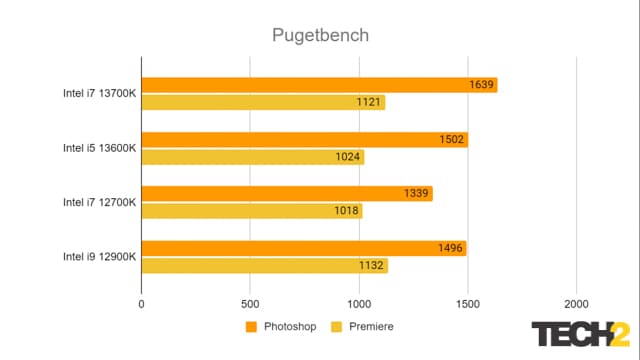
If we take a closer look at how the cores behave during the Cinebench, we see that the i7 13700K maintained an all-core frequency of 5.2 GHz for the P-cores and 4.1GHz for the E-cores after an hour of load testing. The 13700K thereafter appeared to sustain a clock frequency of 5.4 GHz under stress for single-core operations.
Please bear in mind that depending on the load type, this turbo frequency is just for a single core, and there are a plethora of variables that might effect it. Thermal headroom, power limit, cooling solution, thermal paste application, how excellent a motherboard is, and so on, as well as the load type.

In games as well, the CPU performed exceptionally well, which, given its benchmark scores, shouldn’t come as a surprise. In Battlefield 5, we were consistently getting 175+ fps at 1440p, whereas in titles like Far Cyr 6, Forza Horizon 5, and Borderlands 3, we were consistently getting over 100fps at 1440p.
Intel 13th Gen i7 13700K Review: Power consumption & thermals
When it comes to core power usage the i7 13700K is close to the i9 12900K but still slightly lower thanks to Raptor Lake architectural upgrades. Having said that, it is more power-hungry than the i7 12700K.
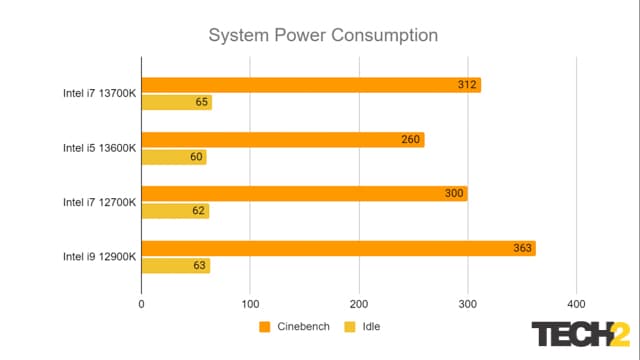
The i7 13700K’s thermal performance is again at par considering its overall speed. Though the i7 13700K runs at 98-99, fluctuating between the two, without hampering the performance.
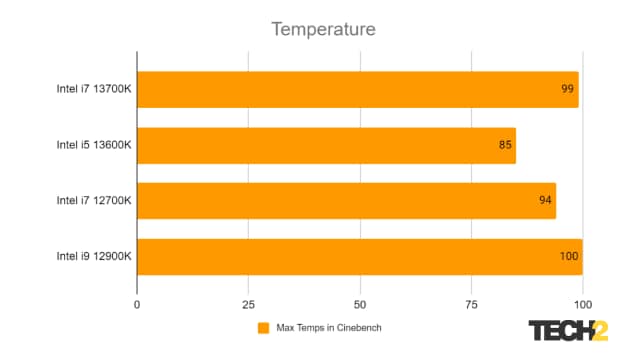
Even under the heaviest of loads, our CPU did not hit the dreaded 100 degrees in a closed case.
Intel 13th Gen i7 13700K Review: Verdict
Overall, the Core i7-13700K has a well-balanced performance profile, with no obvious shortcomings in certain types of productivity apps. As a result, the 13700K is an agile gamer as well as a great all-rounder processor for productive tasks.
The Core i7 13700K has a strong price-to-performance advantage, which is even greater when we consider motherboard and memory costs. Intel has maintained compatibility for DDR4 memory, enabling a route to substantially lower memory and motherboard costs than AMD’s AM5 ecosystem, which needs DDR5 memory. Intel claims that if a previous-generation 600-series motherboard has appropriate power delivery, you won’t lose any performance, offering up another avenue for value hunters.
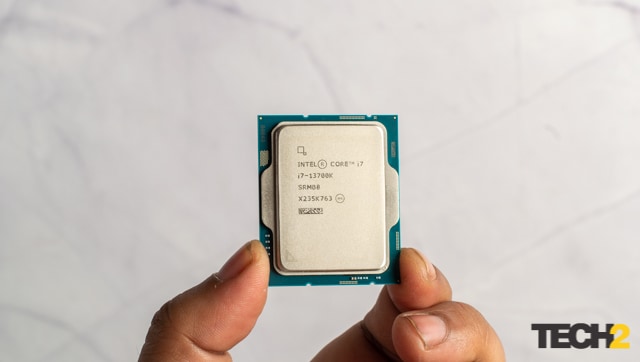
If you’re looking only to game on your system and are looking for a reasonable, mid-tier gaming tower, then the Intel Core i5 13600K is still the better choice, as you can easily start off lower and then build your system gradually, especially if budget is a constraint for you and you’re sure you won’t get into serious content creation anytime soon.
However, if you plan on streaming or any serious content creation, you will be better off with the Core i7 13700K. Think of it this way – it is considerably friendlier on the pocket if you try and spec out a similar machine from team red, and even then, you will be leaving some single-threaded as well as multithreaded performance on the table. You will effectively have to spend considerably more if you plan on getting an AMD machine, that performs like the i7 13700K. And because the performance is almost at par with last year’s i9 12900K, if not better in most scenarios, you get to enjoy the fruits of top-of-the-line CPU, but at a significantly lower cost.






